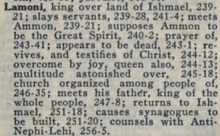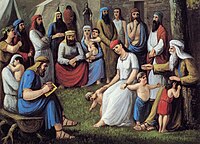The Book of Enos is the fourth book in the Book of Mormon and is a portion of the small plates of Nephi. According to the text it was written by Enos, a Nephite prophet.

The Book of Helaman is one of the books that make up the Book of Mormon, a text held sacred by churches within the Latter Day Saint movement, including the Church of Jesus Christ of Latter-day Saints. The book continues the history of the Nephites and the Lamanites from approximately 50 BC to 1 BC. It discusses political unrest among the Nephites and the formation of a group of secret dissenters called the Gadianton Robbers. Helaman, son of Helaman leads the Nephites for a time, and his sons Nephi and Lehi go on a successful mission to the Lamanites. When Nephi returns home, he correctly identifies the murderer of the chief judge using his prophetic powers, and sends a famine to the Nephite which lasts three years. After a digression from Mormon, the book of Helaman ends with Samuel the Lamanite's prophecy of the signs that will precede Christ's birth and death. Helaman deals with themes of external and internal conflict, hidden information, Nephite racism, and Mormon's views of history as deduced by his redaction of it.
The Book of Jarom is the fifth book in the Book of Mormon. According to the text it was written by Jarom, who was the son of Enos and a descendant of Jacob, the brother of the prophet Nephi.
The Book of Omni is one of the books that make up the Book of Mormon, a text that the Latter Day Saint movement regards as scripture. The book is written as the combined composition of several authors, the first of whom, Omni, provides the name of the book. According to the narrative, the book covers more than two centuries of Nephite history within one chapter of text. It refers to wars between the Nephites and Lamanites, the reign of Kings Mosiah and Benjamin, and their participation in the wars and journeys through the wilderness.
The Words of Mormon is one of the books that make up the Book of Mormon, a text that is held sacred in the Latter Day Saint movement. It consists of a single chapter of eighteen verses and is the only book in the text which is not titled as a "book." According to the text, it is a comment inserted by the prophet Mormon while compiling the records which became the Book of Mormon.
The First Book of Nephi: His Reign and Ministry, usually referred to as First Nephi or 1 Nephi, is the first book of the Book of Mormon, the sacred text of churches within the Latter Day Saint Movement, and one of four books with the name Nephi. First Nephi tells the story of his family's escape from Jerusalem prior to the exile to Babylon, struggle to survive in the wilderness, and building a ship and sailing to the "promised land", commonly interpreted by Mormons as the Americas. The book is composed of two intermingled genres; one a historical narrative describing the events and conversations that occurred and the other a recounting of visions, sermons, poetry, and doctrinal discourses as shared by either Nephi or Lehi to members of the family.
The Second Book of Nephi, usually referred to as Second Nephi or 2 Nephi, is the second book of the Book of Mormon, the primary religious text of the Latter-day Saint Movement. Narrated by Nephi, son of Lehi, unlike the first Book of Nephi, 2 Nephi contains little history of the Nephite people and focuses predominately on visions and prophecies of Nephi himself and other prophets, particularly Isaiah.

The Book of Mormon is the name of a book, or subdivision, of the larger Book of Mormon. This "inner" book has nine chapters. According to the text, the first seven chapters were abridged by the prophet Mormon and the last two by his son Moroni.

Nephi is one of the central figures described in the Book of Mormon. In the Church of Jesus Christ of Latter-day Saints, he is described as the son of Lehi, a prophet, and the founder of the Nephite people. The Book of Mormon also describes him as the author of its first two books, First and Second Nephi.

King Noah is a Nephite king in the Book of Mormon who appears in the Book of Mosiah. Noah rules over a colony of Nephites who come from Zarahemla and settle in the land of Lehi-Nephi, succeeding his father, Zeniff. In the Book of Mosiah, King Noah distances from his father's teachings, committing what the text calls "all manner of wickedness." Noah and his priests sentence a prophet named Abinadi, who prophesies of his kingdom's downfall if they did not repent, to death by fire. During a Lamanite invasion, Noah and some of his people flee the land, and those who remain are subjected to Lamanite control. Noah attempts to forbid his men from returning to their families, and they burn him at the stake. Noah is succeeded by his son, Limhi.

In the Book of Mormon, Ammon is a prominent Nephite missionary and a son of King Mosiah. He originally opposes the church, but along with his brothers and Alma the Younger, is miraculously converted. Following his conversion he serves a mission to the Lamanites and converts Lamoni and his people.

Zeniff is a king in the Book of Mormon whose personal account is recorded in the Book of Mosiah. He is the father of King Noah and the grandfather of King Limhi. Zeniff is the first king of Nephite colonists who come from Zarahemla and settle in the land of Lehi-Nephi. These Native Americans believe this land to be rightfully theirs by inheritance, even attempting to reclaim the land by force. In an expedition in which he spies for the Nephites, Zeniff claims to see good in the Lamanite inhabitants. He argues against a militaristic approach and causes an internal battle among the Nephite army. Zeniff later leads a group of Nephites back to Lehi-Nephi and establishes a peace treaty with the Lamanite king whose people inhabit the land. Zeniff’s people prosper with him as king, but the Lamanite king betrays their treaty and attempts to exploit them. Zeniff and his people successfully fight off the Lamanites’ multiple aggressions, and Zeniff's reign lasts about forty years, after which he passes the kingship to one of his sons, Noah. Scholarly interpretations have highlighted Zeniff's shifting perceptions of Lamanites, such as how his opinion changes when his people contends with the Lamanites and the role that Zeniff's narration plays in racializing Lamanites in the Book of Mormon.

According to the Book of Mormon, Ammoron was a Nephite traitor. A descendant of Zoram, he succeeded his brother Amalickiah as the king of the Lamanites. Amalickiah, as king, started a major war with the Nephites, which the Nephites had hoped would end with his death. However, Ammoron seized power and continued the war. Eventually his armies were defeated after he was assassinated by Teancum.
This chronology outlines the major events in the history of the Book of Mormon, according to the text. Dates given correspond to dates in the footnotes of the Church of Jesus Christ of Latter-day Saints edition of the Book of Mormon and to a Jaredite timeline proposed by Latter-Day Saint scholar John L. Sorenson.

In the Book of Mormon, Amalickiah was a Nephite dissenter. His first appearance in the text is as a political dissident with aspirations to re-establish a monarchy. Later, after seizing the Lamanite throne, Amalickiah led a war to enslave the Nephites. After his death he was succeeded by his brother Ammoron. The story appears in the latter half of the Book of Alma.

In the Book of Mormon, Zeezrom is a Nephite lawyer who, through deceit and money, seeks to gain power among the Nephites through his vocation. Alma the Younger and his missionary companion Amulek teach Zeezrom in Ammonihah. At first he resists, but is ultimately converted to the Nephite religion.

Abish is a figure in the Book of Mormon who plays a pivotal role in a missionary narrative. She is one of only three named women unique to the Book of Mormon.

In the Book of Mormon, Ammon is a Mulekite descendant and leader of a Nephite expedition from Zarahemla, sent to discover the fate of Zeniff and his people. Zeniff and his followers left Zarahemla and travelled to Nephi, their ancestral home, which was then in the possession of the Lamanites. This may have contributed to his expedition, not knowing the actual route to Nephi.

The following outline is provided as an overview of and topical guide to the Book of Mormon:








